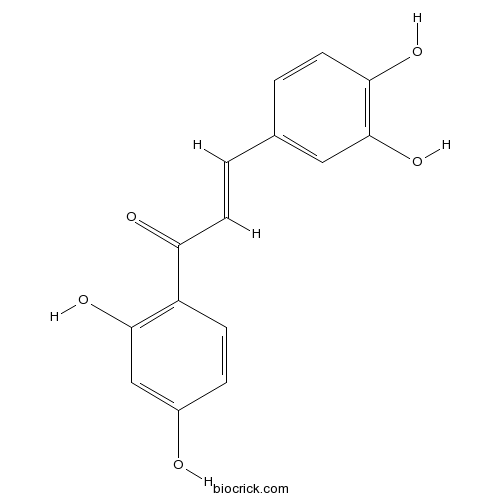Toxicodendron succedaneum
Toxicodendron succedaneum
1. The products in our compound library are selected from thousands of unique natural products; 2. It has the characteristics of diverse structure, diverse sources and wide coverage of activities; 3. Provide information on the activity of products from major journals, patents and research reports around the world, providing theoretical direction and research basis for further research and screening; 4. Free combination according to the type, source, target and disease of natural product; 5. The compound powder is placed in a covered tube and then discharged into a 10 x 10 cryostat; 6. Transport in ice pack or dry ice pack. Please store it at -20 °C as soon as possible after receiving the product, and use it as soon as possible after opening.
Natural products/compounds from Toxicodendron succedaneum
- Cat.No. Product Name CAS Number COA
-
BCN5592
Butein487-52-5
Instructions

The origin of wild populations of Toxicodendron succedaneum on mainland Japan revealed by genetic variation in chloroplast and nuclear DNA.[Pubmed: 29124465]
Toxicodendron succedaneum: (L.) Kuntze is a tree cultivated for the production of sumac wax, which is extracted from the mesocarp. There are several hypotheses regarding the origin of T. succedaneum on mainland Japan. In this study, the geographical distribution of genetic variation in 13 wild populations on Honshu, Shikoku, Kyushu, and Ryukyu Islands, Japan was investigated and compared with that of individuals from continental Asia. Seven chloroplast DNA haplotypes of T. succedaneum were observed in Japan and could be divided into three lineages based on relatedness between haplotypes. One of these lineages was also observed in continental Asia, and the others were genetically distant from the haplotypes that originated on the continent, with one considered to have originated on the Ryukyu Islands, and the other on mainland Japan. The genetic diversity of both chloroplast and nuclear DNA was lower in populations from Ryukyu Islands than in populations from mainland Japan. Bayesian clustering based on nuclear genotypes showed a clear difference between the groups from Ryukyu Islands and mainland Japan. Based on approximate Bayesian computation analysis of polymorphic data for both genomes, it was inferred that wild populations of T. succedaneum on mainland Japan consist of both lineages with natural distribution on mainland Japan and those introduced from Ryukyu Islands and continental Asia.
Physiological responses and accumulation of pollutants in woody species under in situ polluted condition in Southern China.[Pubmed: 22806581]
Physiological leaf traits and accumulation of pollutants of ten woody species in response to air pollution at seriously polluted site Sanguigang (SGG) and control site Maofengshan (MFS) in Southern China were studied. Net photosynthetic rates of most species at SGG were lower than those at MFS, but stomatal conductance (g(s)) showed opposite trend. The specific leaf area of Aporusa dioica, Sapium discolor, Schefflera octophylla and Toxicodendron succedaneum were significantly, 46.77, 13.09, 55.11 and 23.51 %, higher in SGG than in MFS, while chlorophyll content being the opposite. A. dioica had the highest sulphur (S) content at both sites (11.74 mg g(-1) at SGG and 11.07 mg g(-1) at MFS). Heavy metals concentrations were generally higher in species at SGG than at MFS. S. octophylla showed significantly higher concentrations of Zn, Cd and Mn (341.81, 2.41 and 2,287.29 μg g(-1)) than other species at SGG. Moreover, A. dioica had the highest Pb concentration (9.19 μg g(-1)), and L. glutinosa showed the highest Cr concentration (3.40 μg g(-1)). According to the integrated results, we infer that A. dioica, S. octophylla and L. glutinosa are the promising species for phytoremediation in the ceramic industry polluted environment.
Heracleum mantegazzianum and Toxicodendron succedaneum: plants of human health significance in New Zealand and the National Pest Plant Accord.[Pubmed: 17721567]
New Zealand's National Pest Plant Accord (NPPA) is a voluntary and cooperative agreement between industry, regional councils, and central government departments with biosecurity responsibilities (primarily the Ministry of Agriculture and Forestry and the Department of Conservation). Plant species included in the NPPA are declared unwanted organisms under the Biosecurity Act 1993, which prevents their sale, propagation, or distribution across the country. Although MAF Biosecurity New Zealand (the lead agency in New Zealand's biosecurity system) has evaluated the potential human health impacts of 202 species considered for inclusion in the NPPA, two species were examined primarily due to their significance to human health: Heracleum mantegazzianum (giant hogweed, cow parsnip, wild parsnip) and Toxicodendron succedaneum (rhus tree, wax tree, Japanese wax tree). As a result of this process, H. mantegazzianum has been listed in the NPPA. In contrast, T. succedaneum was not included in the NPPA, as the latter was deemed to be an inappropriate mechanism for its control. In this article the NPPA process is outlined, and the adverse impacts on human health of these two species are discussed--including symptoms, treatment, and possible management measures.
Allergic contact dermatitis to Toxicodendron succedaneum (rhus tree): an autumn epidemic.[Pubmed: 7739818]
To document all cases of allergic contact dermatitis (phytodermatitis) due to contact with Toxicodendron succedaneum (rhus tree) presenting to a dermatology clinic during 1993.


